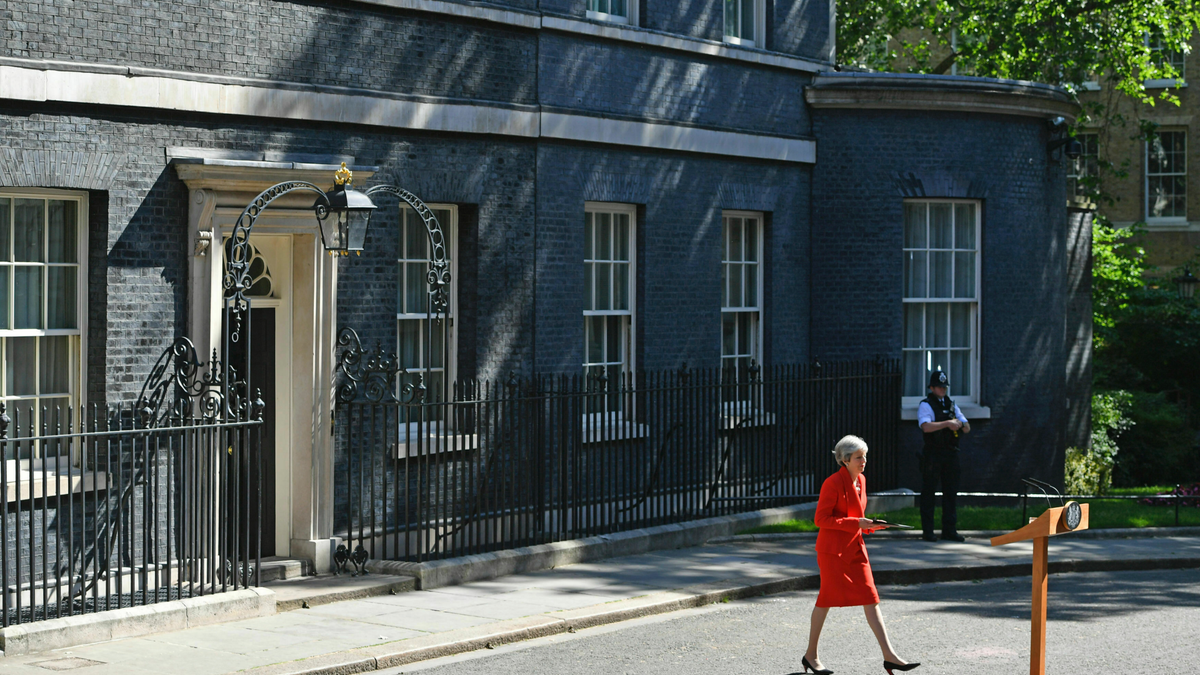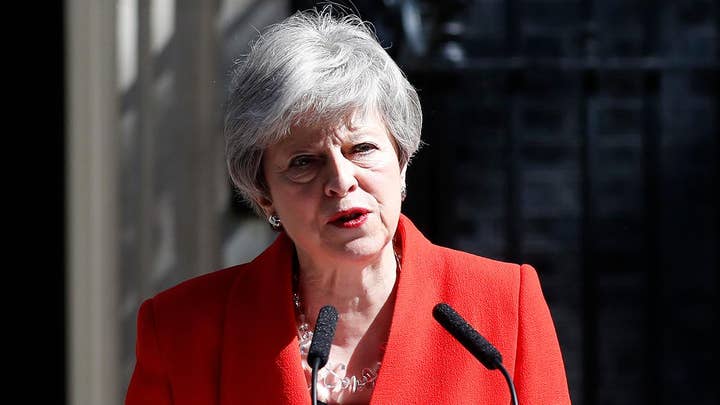Theresa May announces resignation: What's next for the UK and Brexit?
British Prime Minister Theresa May announces she is stepping down on June 7 amid anger over her handling of Brexit; Greg Palkot reports on who may step into the job and the future of Brexit.
LONDON – British Prime Minister Theresa May announced Friday that she will resign -- ending her months-long struggle to keep her job despite seething anger from her own Conservative Party over her handling of Brexit.
UK PM THERESA MAY ANNOUNCES RESIGNATION AMID FURY OVER BREXIT HANDLING
Here is a timeline of key events in how Brexit unfolded and how the political crisis led up to Theresa May's ouster as British prime minister:
May 7, 2015: British voters elect a majority Conservative government. Then-Prime Minister David Cameron confirms in his victory speech that there will be an "in/out" referendum on Britain's EU membership.
Feb. 20, 2016: Cameron confirms that he will campaign for Britain to remain in the 28-nation bloc. The referendum date is set for June.
June 23, 2016: Britain votes 52 percent to 48 percent to leave the EU.
June 24, 2016: Cameron says he will resign in light of the results.

Britain's Prime Minister Theresa May arrives to make a statement outside at 10 Downing Street in London, Friday May 24, 2019. Theresa May says she'll quit as UK Conservative leader on June 7, sparking contest for Britain's next prime minister. (Dominic Lipinski/PA via AP)
July 13, 2016: Following a Conservative Party leadership contest, May, then Home Secretary, becomes prime minister.
Oct. 2, 2016: May says that Britain will begin the formal process of leaving the EU by the end of March 2017. In order to do this, the British government would have to invoke Article 50 of the EU's Lisbon Treaty.
March 29, 2017: The British government formally triggers Article 50, setting in motion a plan for Britain to leave the EU on March 29, 2019.
June 8, 2017: A general election called by May to bolster her party's numbers in Parliament to help with the Brexit negotiations backfires as her Conservative Party loses its majority and continues in a weakened state as a minority government.
July 7, 2018: May and her Cabinet endorse the so-called Chequers Plan worked out at a fractious session at the prime minister's country retreat. It leads to the resignations of Brexit Secretary David Davis, Foreign Secretary Boris Johnson and others who favor a more complete break with the EU.
November 25, 2018: EU leaders approve a withdrawal deal reached with Britain after months of difficult negotiations. May urges British Parliament to do the same.
December 10, 2018: May delays the planned Brexit vote in Parliament one day before it is to be held because it faces certain defeat. She seeks further concessions from the EU.
December 12, 2018: Conservative lawmakers who back a clean break from the EU trigger a no-confidence vote in May over her handling of Brexit. She wins by 200 votes to 117, making her safe from another such challenge for a year.
January 15, 2019: The Brexit deal comes back to Parliament, where it is overwhelmingly defeated in a 432-202 vote.
March 12, 2019: Lawmakers reject deal again.
March 23, 2019: Anti-Brexit protesters flood a central London by the hundreds of thousands demanding a new referendum on whether to leave the EU.
March 28, 2019: May offers up her job in exchange for her Brexit deal, telling colleagues she would quit within weeks if the agreement was passed.
March 30, 2019: British lawmakers reject the government's Brexit deal for a third time.
April 11, 2019: Britain and the EU agree to extend the Brexit deadline to Halloween. The Oct. 31 cutoff date averts a precipitous Brexit on April 12.
THERESA MAY'S TORIES FACE HUGE DEFEAT IN EU ELECTIONS; NIGEL FARAGE'S BREXIT PARTY SURGES
NIGEL FARAGE BLASTED BY RIVALS AS THEY FACE THRASHING FROM BREXIT PARTY AT EUROPEAN ELECTIONS
May 7, 2019: The UK government acknowledges for the first time that the country will definitely take part in the European Parliament elections because there's no chance that a Brexit deal can be approved in time to avoid them
May 17, 2019: Talks between Britain's Conservative government and the opposition Labour Party seeking a compromise over Brexit break down without agreement plunging the country back into a morass of Brexit uncertainty.
May 21, 2019: May offers a concession to lawmakers, giving them the chance to vote on whether to hold a new referendum on the country's membership in the EU — but only if they back her thrice-rejected Brexit agreement.
May 24, 2019: May says she will step down as Conservative Party leader on June 7 and will serve as caretaker prime minister until her successor is chosen.



